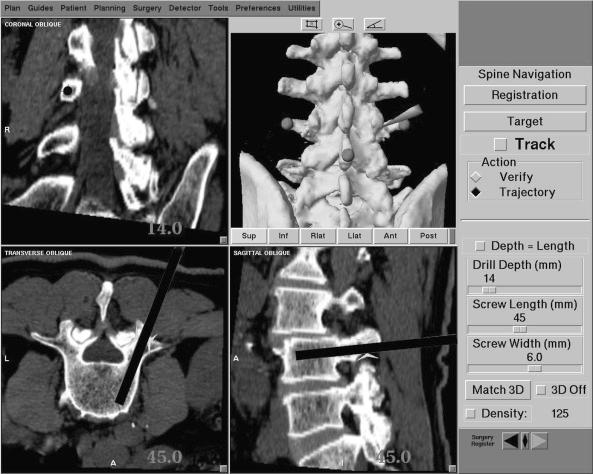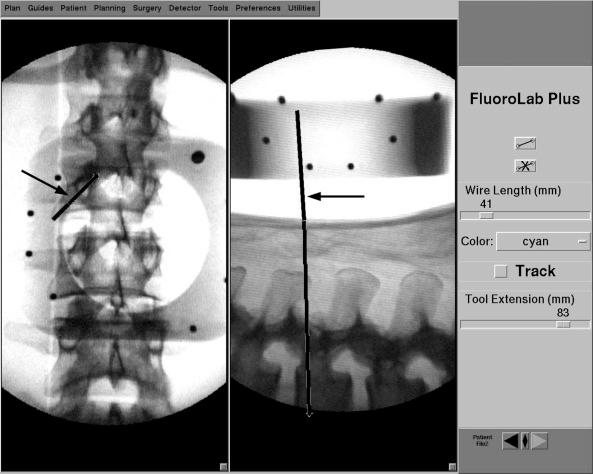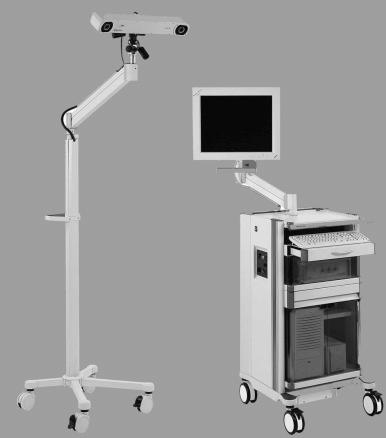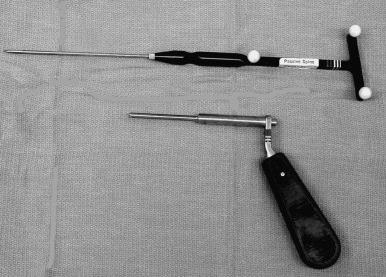Physical Address
304 North Cardinal St.
Dorchester Center, MA 02124
|
|
|
|
|
|
|
|
The management of spinal disorders has been greatly influenced by the development and use of screw-based fixation devices. Accurate placement of these screws requires the spinal surgeon to have a precise orientation to that part of the spinal anatomy that is not exposed in the surgical field. Although conventional intraoperative imaging techniques, such as fluoroscopy, have proven useful, they are limited in that they provide only two-dimensional imaging of a complex three-dimensional structure. Consequently, the surgeon is required to extrapolate the third dimension based on an interpretation of the images and knowledge of the pertinent anatomy. This situation can result in varying degrees of error when placing screws into that part of the spinal column that is not visualized in the surgical field.
Several studies have shown the unreliability of routine radiography in guiding the appropriate trajectory for placement of pedicle screws in the lumbosacral spine. The rate of disruption of the pedicle cortex by an inserted screw ranges from 15% to 31% in these studies. The disadvantage of these conventional radiographic techniques for orienting the spinal surgeon to unexposed spinal anatomy is that they display, at most, only two planar images. Although the lateral view can be relatively easy to assess, the anteroposterior (AP) or oblique view can be difficult to interpret. For most screw fixation procedures, the position of the screw in the axial plane is most important. This plane best demonstrates the position of the screw relative to the neural canal. Conventional intraoperative imaging cannot provide this view.
An additional concern of conventional intraoperative imaging is the radiation exposure experienced by the surgical team and the patient. Rampersaud and colleagues demonstrated that, compared with other orthopedic procedures using intraoperative fluoroscopy, spinal procedures potentially result in a 10- to 12-fold increase in radiation exposure to the surgical team because of such factors as backscatter radiation and the increased energy levels needed to image the lumbar spine. These conditions create a potentially significant hazard to those individuals who perform a high volume of complex spinal surgery.
Computer-assisted spinal surgery, or image-guided spinal navigation, is a computer-based surgical technology designed to improve intraoperative orientation to the nonvisualized anatomy during complex spinal procedures. It provides the spinal surgeon with the ability to manipulate multiplanar computed tomography (CT) or fluoroscopy images during the procedure to gain a greater degree of orientation to the surgical anatomy and thereby optimize the precision and accuracy of the surgery. Compared with conventional intraoperative imaging, image-guided spinal navigation eliminates or significantly reduces radiation exposure to the surgical team.
Image-guided spinal navigation facilitates surgical accuracy by matching spinal image data with its corresponding intraoperative anatomy. It is based on the principle that both the image data and the surgical anatomy represent three-dimensional coordinate systems. Each point in the image data set and in the surgical field has a location in space defined by a specific x, y, and z cartesian coordinate. Using defined mathematical algorithms, a specific point in the image data set can be “matched” with its corresponding point in the surgical field. After matching a limited number of these points together, any point in the surgical field can then be selected and its corresponding point in the images displayed in several planes, to give the surgeon greater orientation to the pertinent surgical anatomy.
Currently, four general options are available for the application of image-guided spinal navigation. CT-based navigation uses CT images of the patient acquired preoperatively. Conventional intraoperative imaging is not necessary. During navigation the surgeon is presented with reformatted CT images in multiple planes with the selected screw entry point and trajectory superimposed on the images ( Fig. 46-1 ). This information updates in real time as adjustments are made to the selected trajectory in the surgical field.

Fluoroscopic navigation uses a standard AP and lateral image of the spinal anatomy acquired in the immediate pre-operative period. No additional intraoperative imaging is needed. The selected trajectory information is superimposed on the AP and lateral images on the workstation screen ( Fig. 46-2 ). Unlike with CT-based navigation, no axial image is available. The advantage of fluoroscopic navigation is that it uses less radiation than conventional fluoroscopy and does not require a preoperative CT scan, as does CT-based navigation. The disadvantage compared with CT-based navigation is that it does not provide an image in the axial plane.

Intraoperative isocentric fluoroscopic navigation is a variation of standard fluoroscopic navigation. Images are acquired in the immediate preoperative period by rotating the specialized C-arm in a 180-degree arc around the patient. These images can then be reformatted to provide images in the axial and sagittal planes similar to CT-based navigation but without the need to acquire a preoperative CT scan. Although the images are not of the same quality as a standard CT image set, they are adequate for navigation in most cases.
Intraoperative CT navigation is the most recent advance in computer-assisted surgery. It consists of a portable CT scanner that uses flat panel detector technology to improve intraoperative image acquisition and quality. The scanner has a configuration similar to that of a standard C-arm fluoroscope. In addition to being able to acquire standard AP and lateral images, its C-arm configuration can be “closed” to encircle the patient completely. This allows the flat panel detector to be swept in a 360-degree arc around the patient and significantly improves the acquired image quality. Images can be acquired preoperatively or intraoperatively and are reformatted into multiplanar views. The advantage over CT-based navigation is the option of intraoperative reimaging after decompression or instrumentation. The reformatted images are similar in quality to conventional CT imaging and are superior to isocentric C-arm imaging. The use of automated registration makes this form of computer-assisted spinal surgery readily applicable to minimally invasive surgery.
The common components of most navigation systems include an image-processing computer workstation interfaced with a two-camera optical localizer ( Fig. 46-3 ). When positioned during surgery, the optical localizer emits infrared light toward the operative field. A handheld navigational probe mounted with a fixed array of passive reflective spheres serves as the link between the surgeon and the computer workstation ( Fig. 46-4 ). Passive reflectors can also be attached to standard surgical instruments. The spacing and positioning of the passive reflectors on each navigational probe or customized trackable surgical instrument are known by the computer workstation. The infrared light that is transmitted toward the operative field is reflected back to the optical localizer by the passive reflectors. This information is relayed to the computer workstation, which can then calculate the precise location of the instrument tip in the surgical field, as well as the location of the anatomic point on which the instrument tip is resting.


Become a Clinical Tree membership for Full access and enjoy Unlimited articles
If you are a member. Log in here